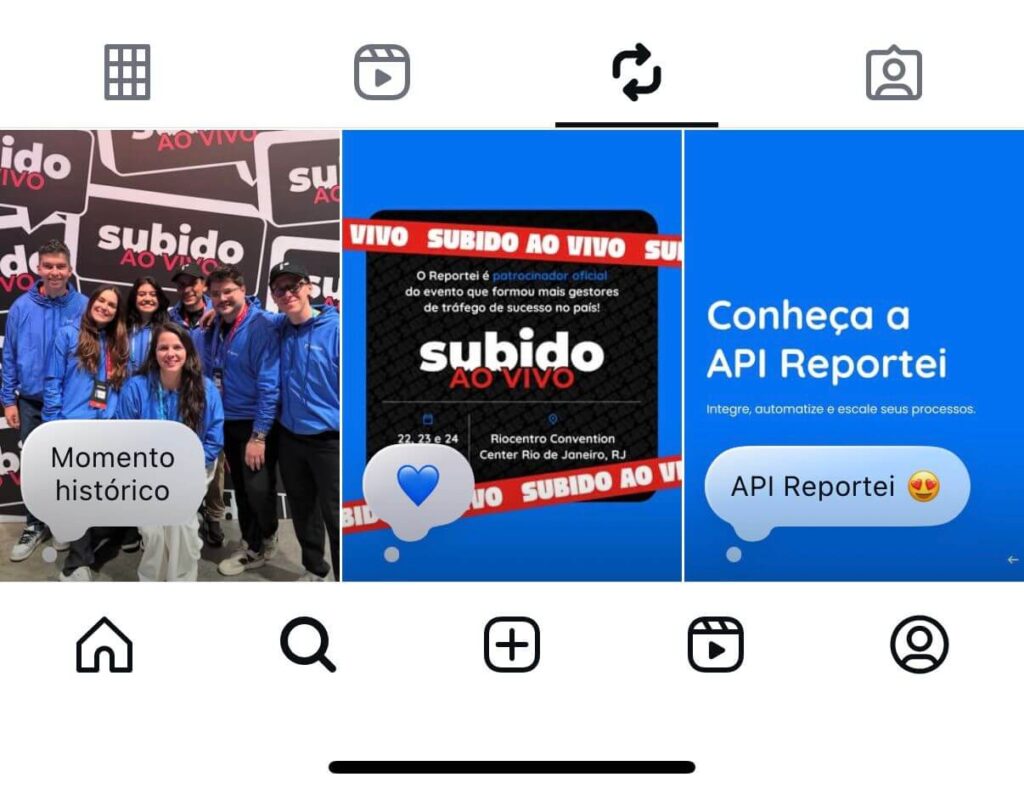Check out the step-by-step guide to reposting on Instagram, the advantages of the strategy, and best practices to adopt.
When we think about increasing reach on Instagram, the first idea is usually to produce more content. But there is a smart shortcut that is fully within the rules to expand the distribution of what’s already working on the app, which is the repost on Instagram.
With it, you share public posts and Reels from other accounts or yours on your feed if you want to give new life to old content, with automatic credit to the author and everything organized in a specific tab on your profile.
Next, check out in more detail what it is, how it works, and when to use this feature in your strategy. Follow along.
What is the repost on Instagram?
The repost on Instagram is a recently launched native feature that allows you to republish public content from third parties in your feed or your own already posted on the app.
Unlike sharing on Stories, where posts are only available for 24 hours, the repost stays on the feed and goes into its own tab. This makes it easier to revisit everything you’ve recommended.
Additionally, Instagram keeps the authorship visible, which provides transparency for those who see the post. and security for those who create.
Thus, for the original creator, the benefit is quite clear: when someone re-posts, the content can be recommended to the followers of the person who performed the action.
On the other hand, for the person who reposted, the advantage is building authority as a curator. After all, the audience begins to associate your profile with good finds within a particular niche.
How the repost feature works for photos, Reels, and videos?
In general, the feature works very simply. Just find public content worth sharing; it can be a post from the feed, a Reel, or a video, and click the repost icon.
From there, three things happen:
- The content reappears in your feed, with a clear indication of who the author is.
- It is considered in recommendations for your friends and followers, which enhances the discovery effect.
- Finally, the post goes to the Reposts tab on your profile, which functions as a library of your curation.

In other words, a win-win flow is created: those who publish maintain credit and traffic, and those who share gain reach and editorial consistency without having to produce everything from scratch.
Step-by-step guide on how to repost on Instagram.
As we mentioned above, reposting on Instagram is very practical and quick. Check the step-by-step guide below to perform the action.
- Open the desired content, post, or Reel, but first check if the account is public and if the theme makes sense for your audience.
- Tap the repost icon, it appears alongside post actions like liking and commenting.
- Add an optional note. To do this, tap the bubble that appears on the screen and write a short comment on why you’re sharing, what insight you highlight, or what point you want to discuss.
- Press Save. The content will be reposted on your feed and listed in the Reposts tab of your profile.
- Manage your reposts whenever you want. If you change your mind, you can remove a repost at any time in the tab itself.

Additionally, it’s good to leave a reminder: the goal of reposting on Instagram is to be useful to your audience.
Therefore, use it to reinforce your position, open debates, and complement your editorial line, not to replace all original production.
Difference between manual repost and via app.
For a long time, users manually reposted Instagram content. That is, they downloaded the video, took a screenshot of the post, uploaded it again, and added credits in the caption.
Although common, this route can present some issues like:
- Legal risk: after all, without explicit permission, you might infringe copyright, and in campaigns, this is even more sensitive.
- Loss of context: when you upload the content again, you create a new post disconnected from the original, meaning comments, metrics, and authorship are lost.
- Rework: it’s a slower process, more prone to error, and depends on third-party apps.
On the other hand, the native feature solves nearly all of this, maintains automatic credit, links to the original post, and reduces obstacles.
But in specific cases, for example, if you need to edit a clip for a compilation, you can assess whether it’s worth asking for permission and uploading as new content, making it clear it’s a reinterpretation, not a repost.
Advantages of using repost on Instagram for brands and creators.
For all these reasons, we can see that reposting is a smart shortcut to expanding results without relying solely on new content.
Thus, when used judiciously, that is, aligned with your themes and objectives, and schedule, it enhances what’s already performing well and further strengthens your relationship with the community.
Below, check out the main advantages the strategy offers.
- Scalable reach: reposting leverages different networks to take the same content further.
- Social proof: consistent curation shows you’re attuned to what’s important in the niche and brings repertoire to your audience.
- Lighter schedule: when the week gets tough, strategic reposts maintain frequency without sacrificing quality.
- UGC in the spotlight: testimonials, reviews, and client cases can gain prominence with just a few taps.
- Clear partnerships: together with Collabs and tags, reposting organizes campaigns with creators and partners.
- Longer life cycle: finally, evergreen posts of yours or others get a new chance to attract an audience.
We can see then that reposting multiplies reach, supports the schedule, and strengthens connections, as long as you carefully select what to share, explain why in the caption, and keep the credit visible.
With these precautions, each repost on Instagram becomes a point in favor of your strategy: less operational effort, more consistency, and predictable results.
Best practices and precautions.
As we saw above, reposting is simple, but doing it the right way requires some precautions.
Besides respecting rights and valuing the creator, good practices help maintain your audience’s trust and organize daily tasks.
Thus, below we have gathered some guidelines for you to apply without doubt.
- Ask for permission when necessary: public content is not synonymous with unrestricted commercial use. Thus, in campaigns, use Instagram DM, or email to explain where it will be displayed and keep a record.
- Reinforced credit: besides the automatic attribution, tag the author in your note. It helps the algorithm and values the creator’s work.
- Respect private accounts: the native repost works with public content. Therefore, don’t force shortcuts to bypass this.
- Have editorial criteria: define themes and frequency. After all, repost for repost’s sake can become just noise.
- Measure and learn: track reach, comments, saves, and DMs. Also, adjust the type of content you will repost based on what engages the most.
In essence, reposting is about respect and smart curation. So when you ask for permission in the right scenarios, it reinforces credit, preserves the original meaning, and follows clear criteria, making each repost strengthen your brand, not just fill the schedule.
Also read: How to monetize Instagram?
FAQ: Frequently asked questions about reposting on Instagram.
Finally, to further aid your strategy, we’ve gathered the most common questions about reposting on Instagram below. Check it out.
No, the native repost only works with public content. If it makes sense to use something from a private account, request written permission and consider publishing as new content, clearly stating the context.
Generally, yes, because the content can be recommended to the followers of the person who reposted. But the impact depends on the relevance of the theme, the timing, and the consistency of your curation.
As we mentioned earlier, stories are temporary and suitable for quick reactions. Meanwhile, the repost appears in the feed with a permanent record in the Reposts tab and a greater chance of engagement over time.
You cannot change the original post’s caption. What you can and should do is add your note at the time of reposting, bringing your point of view.
For editorial use and with the native feature, credit already appears. In campaigns and commercial contexts, request permission and keep the agreement recorded. After all, this avoids disputes and safeguards your brand.
Prefer the native feature. This is because external apps tend to break attribution, require a new upload, and increase the risk of copyright issues.



